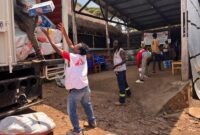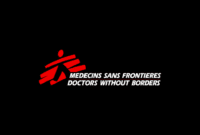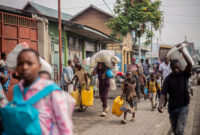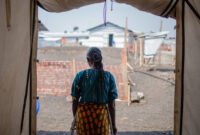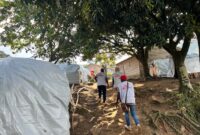DRC: a “total dead end” for displaced people in Goma
More than one million people have fled the fighting linked to the resurgence of the M23 armed group in North Kivu province in eastern Democratic Republic of Congo (DRC). Hundreds of thousands of them currently live in complete destitution in overcrowded camps in Goma, the provincial capital, and the surrounding area. Claire Magone, MSF-France’s Executive Director, went there at the end of July. In this interview, she discusses the scale of the needs, the current mobilisation of aid organisations and the prevalence of sexual violence.
What is the situation in the camps around Goma?
The hundreds of thousands of people who arrived in Goma from March 2022 onwards are at a total dead end. They were brought there by a series of displacements and they now have absolutely no prospects. The expression most frequently used to describe the situation in the camps is that they are unfit to live in. These are populations who have been left to fend for themselves, with little attention and little assistance, and who are exposed in every sense of the word: to disease and malnutrition and to the elements, because they live in unfit shelters, but also to every form of violence, which is aggravated by the extreme overcrowding.

Families cram together and survive as best they can in unsanitary and overpopulated camps. Landowners around Goma refuse to provide access to land and the government’s commitment to make 115 hectares available for displaced people has not yet been fulfilled. The situation is a dead end in terms of lack of prospects, but it is also a physical and geographical dead end: these are people who had already lost everything on the way, who find nothing when they arrive and who live in complete destitution.
In May, MSF warned of a particularly high number of cases of sexual violence, with up to 50 women coming to MSF clinics every day at the time. What is the situation today?
Sexual exploitation and violence are directly fuelled by the living conditions and the lack of assistance. Most of the displaced women in the Goma camps live under constant threat of intrusion in makeshift shelters made of foliage and pieces of plastic. Many of them are assaulted when they go to collect firewood outside the camps; others are trapped in exploitation networks – in brothels in the city or inside the camps – or subjected to forms of sexual blackmail inside the camps.
A graphic example is the water points – including those set up by MSF – that are used both by families in the camps and by armed men who can convince a woman who goes to fetch water that they are in charge of access to it.
Being aware of the imbalance in the relationship between women who have nothing and men who hold a form of power (armed men, but also block leaders in the camps, recruiters, caregivers, guards, etc.) means that we must be constantly alert to abuses of power that may be committed by humanitarian aid personnel. We must encourage women to report these abuses, strengthen our mechanisms for prevention and handling of the cases reported to us, and punish them.
What do the authorities and aid organisations have to say about this issue and what can be done to improve the protection and care provided to women as well as their access to treatment?
There is a kind of doublespeak on the issue of sexual violence, which consists in expressing indignation at its prevalence while simultaneously questioning the scale of the phenomenon or its causes: there are some who argue, for example, that out of boredom or a “taste for easy money”, women choose prostitution. In reality, they have no choice in their situation.
Others insinuate that some women lie about being raped in order to access services – for example to get clothing, food or any other form of social assistance. These are misogynistic and sexist arguments that we must collectively combat.

The services available to women range from access to abortion and morning-after pills to prevention and treatment of sexually transmitted infections (STIs) and psycho-social support – services that should be available to all women who express the need for them, whether they have been victims of sexual violence or not.
What is the current level of humanitarian mobilisation?
In recent months, MSF has called several times for a mobilisation of aid organisations. In June, the United Nations classified the situation in Ituri, North Kivu and South Kivu provinces as a level 3 (L3) emergency, allowing rapid mobilisation and an increase in the humanitarian response.
Between March and June there was a growth in awareness on the part of the United Nations and other players of the need to increase assistance. The coordination mechanisms and the organisation of the humanitarian aid system itself should improve, particularly through the relocation of experienced personnel from Kinshasa to Goma, as close as possible to the needs. A dedicated €1.5 billion ($2.15 billion CAD) financing plan (which we already know will only be partially covered), i.e. €500 million ($718 million CAD) more than the budget initially earmarked for the DRC, is supposed to enable priority actions to be targeted, particularly in terms of food security, access to water and care for victims of sexual violence.
However, this initial mobilisation is still slow to turn into tangible improvements for the displaced people concerned: quality of shelters, number of square feet of living space per person, availability of water and sanitation infrastructure, quantity of food aid, etc. In all these areas, the assistance provided is well below the minimum standards formalised under the SPHERE initiative: in the late 1990s, these standards were defined by humanitarian organisations precisely because the aid provided to the populations affected by the Great Lakes crisis was considered disgraceful!
What role are the Congolese authorities playing in this mobilisation?
It must be acknowledged that the concerns expressed by the authorities about the fate of displaced populations and the need to help them are now just window dressing. In practice, they do nothing to facilitate issuing of visas for international staff, supply procedures or coordination of the players involved. On the contrary even, bureaucratic and administrative obstacles are increasing.
In this context, what constraints and concerns does MSF have?
The situation of the displaced populations and our ability to help them is currently our main concern. In Goma, the displaced population is cornered, and in areas under M23 control, where MSF is one of the few organisations still working, the populations live in the thick of the fighting.
The general climate of insecurity does not encourage optimism. There could be said to be a real arms race in North Kivu, with armed groups and young people galvanized by patriotic speeches and calls for mobilisation, and little hope of de-escalation in the conflict with M23. Many observers are worried about the possibility of massive new waves of displaced people, particularly if the advance of M23 or flashpoints with the armed groups were to ignite the powder keg in Goma – a city that has taken in more than 600,000 new displaced people in nine months and that would be completely unable to cope with an influx of several hundred thousand more.
The struggle to survive
Justine, Alice, Tuliza and Agnes fled fighting linked to the resurgence of the M23 armed group in North Kivu Province in eastern DRC. These internally displaced women tell of the violence they fled or suffered, and of their daily struggle to survive.




